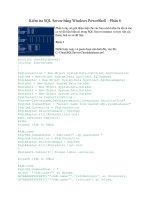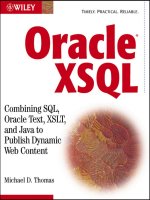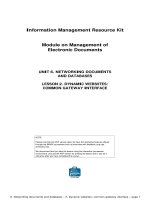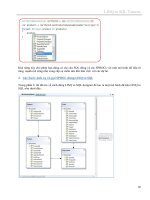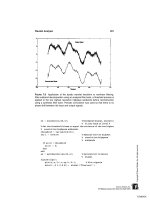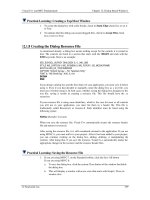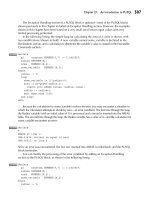Oracle XSQL combining sql oracle text xslt and java to publish dynamic web content phần 6 doc
Bạn đang xem bản rút gọn của tài liệu. Xem và tải ngay bản đầy đủ của tài liệu tại đây (594 KB, 60 trang )
After observing these rules, you have a well-formed document. This is all that you
need to use your HTML as an XSLT stylesheet. To go ahead and make your document
XHTML, it must validate against one of the XHTML DTDs that are listed in Table 12.3.
This involves putting a DOCTYPEdeclaration at the top of your file. When you transi-
tion your XHTML to an XSLT stylesheet, you will need to remove the DOCTYPE decla-
ration.
Generally, you are going to want to use the Transitional DTD. You declare this
by using the following at the top of your document:
<!DOCTYPE html PUBLIC “-//W3C//DTD XHTML 1.0 Transitional//EN”
“ />If you use frames and you want your frameset page to be XHTML, you need to use
the following DOCTYPE declaration:
<!DOCTYPE html PUBLIC “-//W3C//DTD XHTML 1.0 Frameset//EN”
“ />If you wish to use the Strict DTD, this is the declaration that you want:
<!DOCTYPE html PUBLIC “-//W3C//DTD XHTML 1.0 Strict//EN”
“ />The key requirement that both the Transitional and Strict DTDs enforce is
that a head section is required. Even if it is empty, you still have to have it. The strict
DTD goes a bit further on a couple of points: It is much stricter about structure and
doesn’t allow deprecated attributes.
Table 12.3 XHTML DTDs
DTD DESCRIPTION
Transitional Probably your best bet. It is loose and allows you
to create code that is largely compatible with older
HTML standards.
Strict This DTD enforces all of XHTML rules, especially
pertaining to how documents must be structured.
Its use could cause backward compatibility
problems for older browsers.
Frameset The frameset DTD is used on pages that describe
framesets.
280 Chapter 12
When using the Strict DTD, you will probably run into the structural require-
ments when a child element of the body tag isn’t a block element. Only block elements
can be direct children of the body element. The following are block elements:
HEADING ELEMENTS
<h1>
<h2>
<h3>
<h4>
<h5>
<h6>
LIST ELEMENTS
<ul>
<ol>
<dl>
BLOCKTEXT ELEMENTS
<pre>
<hr>
<blockquote>
<address>
<div>
<table>
<fieldset>
<ins>
<del>
<script>
<noscript>
The other implication of this is that text can’t dangle inside the body tag. It must be
enclosed in something—usually a <p> element. The Strict DTD also forbids the use
of deprecated attributes. This is more troubling, because you lose compatibility with
older browsers because of this. The structural requirements lead to better HTML, but
using the Strict DTD works against good, open site design because it takes away
older features from you. Generally, the Transitional DTD is preferred.
XSLT 281
A Simple XHTML Transformation
This section defines precisely what XHTML is and how it relates to traditional HTML.
The first step is to look at a typical legal HTML document that isn’t XML compliant.
Then, you’ll make it XML compliant by transitioning it to XHTML. This section con-
cludes with a review that spells out the key rules that define XHTML.
To begin, please consider the following HTML document:
<html>
<body>
<H1>Hello!</H1>
<p>
<IMG SRC=blah.gif ID=my_picture>
<br>
Hi! This is my home page. I want to tell you a few things.
<p>
<ul>
<li>I like playing on the Internet
<li>I just want to dance!
<li>I wok in the would
</UL
That’s about all <br>
I have for now. <BR>
<p>
Maybe I’ll have <br>
more to say <Br>
later. <bR>
<Hr>
<b><i>Later!</B></I>
</boDY>
</HTML>
This HTML is quite ugly, but it will work in most all Web browsers. However, it
doesn’t stand a chance of being a valid stylesheet and is a long way from being valid
XHTML. Let’s examine the worst offense first:
<b><i>Later!</B></I>
The tags aren’t properly nested. As you learned in Chapter 3, “Hello, XSQL!”, the
tags have to be properly nested for an XML document to be well formed. The first step
is therefore to straighten that out. This yields the following:
<b><i>Later!</B></I>
However, you still aren’t out of the woods. XML, unlike HTML, is case sensitive.
These tags aren’t a well-formed fragment, because the closing tags are capitalized,
whereas the opening tags aren’t. This line needs to be fixed to be:
<b><i>Later!</b></i>
282 Chapter 12
Our document has this case mismatch with almost all of the opening and closing
tags. Going through and making the end tags match all of the start tags fixes most of
this problem. However, the one set of tags that already match have their own problem:
<H1>Hello!</H1>
XHTML requires that all element names be in lower case. Thus, this needs to be
changed to:
<h1>Hello!</h1>
Now, all of the start tags have matching end tags, and all of the tag names are low-
ercase. However, our document still isn’t well formed. Our document includes several
common HTML tags—<img>, <p>, <hr>, <br>, and <li>—that are illegal in XML.
They have the form of the start tag, but they don’t have a matching end tag. They
should either have an end tag or take the form of an empty tag. XHTML requires that
the <img>, <hr>, and <br> tags should be empty tags, while <p> and <li> should be
closed with </p> and </li>, respectively.
These aren’t the only tags in traditional HTML that aren’t XML compliant. Table 12.1
describes how to handle the remaining tags that either should be empty or should be
closed. But before exploring that, you are only a couple steps away from having an
XHTML document. Our next problem deals with attributes. Attributes must be quoted,
and the attribute names must be lowercase. This yields the following:
<img src=”blah.gif” name=”my_picture” />
You need one other fix on the img element: The name attribute used by a, applet,
frame, iframe, img, and map is deprecated in XHTML and replaced by the id
attribute. The easiest way to fix this and to maintain compatibility is to specify the id
attribute and the name attribute. Also, the alt attribute is required in XHTML.
<img src=”blah.gif”
name=”my_picture”
id=”my_picture”
alt=”blah blah blah”/>
There is one fix left. The hr tag has a minimized attribute, “no_shade”. Such attrib-
utes aren’t allowed in XML, because attributes must have a value. The <hr> tag should
be changed to:
<hr noshade=”noshade”/>
Now you have completed the transformation of the document to XHTML. Here is
the final product. It validates against the Transitional XHTML DTD.
<?xml version=”1.0” encoding=”UTF-8” ?>
<!DOCTYPE HTML PUBLIC “-//W3C//DTD HTML 4.01 Transitional//EN”>
<html>
XSLT 283
<head>
<title>Hello!</title>
</head>
<body>
<h1>Hello!</h1>
<p>
<img src=”blah.gif” id=”my_picture” name=”my_picture” alt=”blah
blah blah”/>
<br/>
Hi! This is my home page. I want to tell you a few things.
</p>
<ul>
<li>I like playing on the Internet</li>
<li>I just want to dance!</li>
<li>I wok in the would</li>
</ul>
<p>
That’s about all <br/>
I have for now. <br/>
</p>
<hr noshade=”noshade” />
<p>
<b><i>Later!</i></b>
</p>
</body>
</html>
If you want compliance with strict XHTML, then you simply need to remove the
deprecated attributes and add the namespace attribute to the HTML element. The fol-
lowing file is in compliance with Strict XHTML.
<?xml version=”1.0” encoding=”UTF-8”?>
<!DOCTYPE html
PUBLIC “-//W3C//DTD XHTML 1.0 Strict//EN”
“ /><html xmlns=” xml:lang=”en” lang=”en”>
<head>
<title>Hello!</title>
</head>
<body>
<h1>Hello!</h1>
<p>
<img src=”blah.gif” id=”my_picture” alt=”blah blah blah”/>
<br/>
Hi! This is my home page. I want to tell you a few things.
</p>
<ul>
<li>I like playing on the Internet</li>
<li>I just want to dance!</li>
284 Chapter 12
<li>I wok in the would</li>
</ul>
<p>
That’s about all <br/>
I have for now. <br/>
</p>
<hr/>
<p>
<b><i>Later!</i></b>
</p>
</body>
</html>
Compliance with Transitional XHTML is more than enough to ensure compati-
bility with XSLT. The advantage of Strict compliance is that you are fully compati-
ble with the latest version of XHTML. However, there is a price for this compatibility:
Because you aren’t allowed to use deprecated attributes, you lose some backward
compatibility.
Tips and Tricks of Migrating HTML
If you have a lot of old HTML that you want to make into stylesheets, you may be brac-
ing yourself for a daunting task. Not to worry—there are many ways to make the tran-
sition easy. First and foremost, your stylesheets don’t have to be fully XHTML
compliant. They just have to be XML compliant. Because you have to do some work
anyway, there is a strong argument that you might as well bring them fully up-to-date
and make them XHTML compliant. Our first tip shows you how to bring your old
HTML into XML compliance by just using the XSLT processor. From there, some
XHTML tools and validators will be discussed.
Your first step should be to get Dave Ragget’s Tidy utility. It will automatically con-
vert most HTML, even really messy HTML, to well-formed XML. You can locate the
utility by going to either of these URIs:
/> />After installation you can run the tool as follows:
Tidy —output-xhtml yes —indent yes MyOld.html > LikeNew.xhtml
You can then run a document through the validator at validator.w3.org. Simply
put the file on a public Web site, navigate to validator.w3.org, and type in the URI.
You should have one of the XHTML DTDs in place to make sure it is valid XHTML.
From there, your next step is to transition it to a stylesheet. Here is the process:
1. Get rid of any DOCTYPE instructions.
2. Add xsl:version=”1.0” as an attribute/value pair to the html element.
3. Save the file as a stylesheet with the .xsl extension.
4. Create a dummy XSQL file that references the stylesheet.
XSLT 285
Figure 12.3 XSLT error.
The dummy XSQL file doesn’t need to contain any actual SQL queries. In fact, it
should be as simple as possible. This is just a way to check and make sure that the
Oracle XSLT Processor likes your file. The following will do great:
<?xml version=”1.0”?>
<?xml-stylesheet type=”text/xsl” href=”my_stylesheet.xsl”?>
<page>
</page>
If your file is okay, the XSLT processor is just going to display the page to the
browser. After all, there is no actual XSLT code that needs to be processed. However, if
there is a problem with your stylesheet, then the translator will report an error back to
you. Figure 12.3 shows an example.
The error was generated by using the original ugly HTML example that appeared
previously. If nothing else, you can use the XSLT processor to iteratively fix your
HTML, line by line.
Moving On
This chapter gave you a high-level overview of XSLT, which should have comple-
mented the earlier examples that used XSLT. Chapter 13, “XSLT In-Depth,” covers the
details of coding XSLT. Because XSLT controls how your XSQL application looks, it’s
an important part of your overall code. You’ll see this in Chapter 14, “Building XSQL
Web Applications,” when you create your own application. A lot of the overall code is
XSLT stylesheets.
286 Chapter 12
287
This section details all the elements in XSLT based on what they do. It is meant as a
tutorial on the first reading and then a quick reference after that. It starts with the root
element and then introduces all the elements, including their syntax and examples.
The following XSQL is used for all the examples in this section. It produces the data for
the employees in the emp table. To use the examples in this section, be sure to change
href to whatever name you give the stylesheet.
<?xml version=”1.0”?>
<?xml-stylesheet type=”text/xsl” href=”some-stylesheet.xsl”?>
<page connection=”demo” xmlns:xsql=”urn:oracle-xsql”>
<xsql:query>
SELECT * from emp
</xsql:query>
</page>
At this point in your reading, it is assumed that you know how XSLT stylesheets fit
in with the rest of the XSQL framework. In general, a datagram is returned from the
database and in the canonical format, and you use an XSLT stylesheet to transform it
into something useful to the client. With certain actions—xsql:insert-request,
xsql:update-request, xsql:delete-request, and xsql:insert-param—
you can also transform the input using an XSLT stylesheet. From there, you’ll learn
about the selection of values from the inputted XML document.
XSLT In-Depth
CHAPTER
13
This chapter looks at all the details of using XSLT stylesheets. You’ll learn about all
the XSLT elements, as well as XPath, which allows you to search locate nodes in the
inputted XML document. The first discussion concerns the root element; the next dis-
cussion shows you how to control the output with the xsl:output element. From
there, you get into the core of XSLT—templates. You can’t really write a simple exam-
ple without using templates, so you’ve seen them before. In Chapter 14, you’ll get a
chance to apply your knowledge learned here to a real-world application. Also in that
chapter, you’ll see how to iterate through sets of nodes and how to use conditional
logic. From there, you’ll learn about the rest of the XSLT elements, in addition to how
to create XML entities and handle special cases with text, how to number elements,
how to deal with variables and parameters, how to reuse stylesheets, how to sor, and
how to handle whitespace. The chapter concludes by looking at whitespace.
Root Element
A stylesheet is an XML document; thus it requires a root element. The XSLT specifica-
tion says that the root element should be either xsl:stylesheet or its synonym,
xsl:transform. In practice, the Oracle XSLT processor will accept any element as
the root element as long as the attributes required of the xsl:stylesheet element
are attributes of the root. This section looks at the syntax of the root element and pro-
vides examples.
xsl:stylesheet Syntax
The xsl:stylesheet element can only be the root element of an XSLT stylesheet. It
is completely synonymous with the xsl:transform element. Its attributes describe
the stylesheet to the XSLT processor. You can optionally use the html element as the
root and simply add these stylesheet attributes to the html element. The syntax of the
xsl:stylesheet element is below. A stylesheet element is required to be the root ele-
ment and only one stylesheet element is permitted per stylesheet.
<xsl:stylesheet
version = “version_number”
xmlns:xsl = “namespace_URI”
id = “id”
extension-element-prefixes=”extension_prefix_list”
exclude-result-prefixes=”exclude_prefix_list”>
any xml
</xsl:stylesheet>
Table 13.1 lists the attributes.
288 Chapter 13
Table 13.1 xsl:stylesheet Attributes
ATTRIBUTE DESCRIPTION
Version The version of the stylesheet, which
should be 1.0. If it is greater than 1.0,
forwards-compatible processing will be
enabled. This means that the XSLT
processor must process the stylesheet
with the expectation that new features of
XSLT are being used that the processor
doesn’t know about.
Xmlns:xsl The namespace for the stylesheet. The
URL listed should be the namespace. It is
not strictly required, though highly
recommended.
Id An identifier for the stylesheet.
Extension-element-prefixes Whitespace-delimited list of namespace
prefixes of extension elements used in
the stylesheet.
Exclude-result-prefixes Whitespace-delimited list of namespace
prefixes that should be excluded from the
output.
The root element can’t have a parent, but it can have the child elements listed in
Table 13.2. Any xsl:include or xsl:import child elements must precede all other
child elements.
Table 13.2 Children of the Root Element
CHILD ELEMENT
xsl import
xsl include
xsl attribute-set
xsl decimal-format
(continues)
XSLT In-Depth 289
Table 13.2 Children of the Root Element (Continued)
CHILD ELEMENT
xsl key
xsl namespace-alias
xsl param
xsl:preserve space
xsl:strip space
xsl output
xsl template
xsl variable
Examples
Examples are provided of the xsl:stylesheet and xsl:transform elements act-
ing as root, as well as the use of an arbitrary root element. The basic stylesheet element
looks like this:
<xsl:stylesheet
xmlns:xsl = “
version = “1.0” >
. . . XSLT code and other XML
</xsl:stylesheet>
You might occasionally run across a stylesheet that has a root element like this:
<xsl:transform
xmlns:xsl = “
version = “1.0” >
. . . XSLT code and other XML
</xsl:transform>
The XSLT specification defines the xsl:transform element as completely syn-
onymous with the xsl:stylesheet element. All processors should allow this
behavior.
290 Chapter 13
The following example makes use of the other two attributes—extension
-element-prefixes and exclude-element-prefixes.
<xsl:stylesheet
xmlns:xsl = “
version = “1.0”
extension-element-prefixes=””
exclude-element-prefixes=””>
XSLT code and other XML
</xsl:stylesheet>
Controlling the Output
The output of the XSLT processor can be fine-tuned with the xsl:output element.
The xsl:output element is used to communicate directions to the processor about
how to produce the output. By default, XML is produced with a mime-type
text/xml. The xsl:output element can tell the processor that you wish to have
HTML outputted and a mime-type text/html. Though this won’t make much dif-
ference for modern browsers, it can make your code more compatible with older
browsers that predate XML. This section details the syntax of the xsl:output ele-
ment and provides examples of its use.
xsl:output Syntax
The syntax of the xsl:output element, followed by a table describing the attributes,
is given here. As you can see from the syntax diagram, all the attributes are optional. If
all the attributes are omitted, the xsl:output element will have no effect.
<xsl:output
method = “xml” | “html” | “text” | “other”
version = “version_number”
encoding = “char_encoding”
omit-xml-declaration = “yes” | “no”
standalone = “yes” | “no”
doctype-public = “public_identifier”
doctype-system = “system_identifier”
cdate-section-elements = “elements_list”
indent = “yes” | “no”
media-type = “mime-type” />
The attributes are described in Table 13.3.
It is a top-level element and can only appear as the child of the root element. It can’t
have children.
XSLT In-Depth 291
Table 13.3 xsl:output Attributes
ATTRIBUTE DESCRIPTION
method Indicates how the output should look and defaults
to xml. If set to text, non-XML-compliant HTML
tags, such <br> and <hr>, will be converted to
their original HTML form from their XHTML
equivalents, <br/> and <hr/>. If set to text, all
the XML markup will be excluded from the output.
version Provides a version number for the output. This
attribute is ignored by most XSLT processors.
encoding The character encoding that should be used for the
output, such as ISO-8859-1, UTF-16, and UTF-8.
omit-xml-declaration If set to “yes”, the xml declaration will be omitted
from the document.
standalone Sets the value for the stand-alone attribute of the
XML declaration.
doctype-public Outputs the value as a public identifier for the
document within a DTD.
doctype-system Outputs the value as a system identifier for the
document within a DTD.
cdata-section-elements A list of element names that shouldn’t have their
values altered in any way. Generally, these
elements contain characters such as < that are
generally URL-encoded.
indent If set to “yes”, the XSLT Processor can beautify
the output by indenting the XML elements.
media-type The mime-type output. Its default value is text/
xml for the XML method, text/html for the HTML
method, and text/plain for the text method.
Examples
The most common use of the output element is to choose whether xml, text, or html
is output. If you select HTML, XHTML tags such as <br /> will be converted back to
their early HTML form (e.g., <br>). This output element will tell the processor to do
the following:
<xsl:output method = “html” />
292 Chapter 13
You can also request that all XML tags be stripped entirely, leaving only the text
between the tags. This output method produces text only. It also outputs the text in the
iso-8859-1 character set:
<xsl:output method = “text” encoding=”iso-8859-1”/>
The method is global—it changes the way your entire document is output. The
cdata-section-elements attribute works on specific elements. It will wrapper
any text as a cdata element. This action can be quite useful if an output is to be con-
sumed by an application that will interpret it as XML.
<xsl:output method=”xml” cdata-section-elements=”little_script
funny_element” indent=”yes”/>
By default, the output method is XML. This doesn’t mean that Web browsers won’t
understand your result; rather, it just means the original XML structure of the docu-
ment is maintained. Regardless of whether it’s interpreted as HTML, you can make the
XML prettier by using the indent attribute, as follows:
<xsl:output method=”ml” indent=”yes”/>
Let’s say that you don’t want the output to be understood as some other mime
-type, such as Rich Text Format (RTF). You can do this by setting the media-type. In
such a case, you might not want the XML declaration to be at the top of the output. This
output element takes care of both concerns:
<xsl:output method=”text” media-type=”application/rtf” omit-xml
-declaration=”yes”/>
The remaining attributes are used to specify XML instructions. Here is an example
that uses all three of the remaining attributes:
<xsl:output method=”xml”
doctype-public=”-//MDT”
doctype-system=”
standalone=”no”/>
It yields the following at the top of the document:
<?xml version = ‘1.0’ encoding = ‘UTF-8’ standalone = ‘no’?>
<!DOCTYPE html PUBLIC “-//MDT” “ />Templates
Templates are the key to XSLT. Without at least one of the elements presented here,
your stylesheet isn’t going to output much from your XML document. The xsl:
XSLT In-Depth 293
template element defines a template, while the apply-template and call
-template elements declare where in the stylesheet a template should be invoked.
xsl:template Syntax
The syntax for the xsl:template element, follows, and Table 13.4 describes this ele-
ment’s attributes. It is key to all of XSLT, and it occurs in most XSLT stylesheets. It
describes templates that are used to process XML nodes.
<xsl:template
match = “pattern”
name = “name”
priority = “number”
mode = “qname”>
. . .
</xsl:template>
Table 13.5 lists the parent-child relationships.
No attribute is actually required for the xsl:template element, but generally the
match attribute is present. Rarely, the match attribute will be absent, but the name
attribute will be present. Without either the match or the name attribute, the template
can never be used.
Table 13.4 xsl:template Attributes
ATTRIBUTE DESCRIPTION
match The value for this attribute is a pattern that is used
to match xml nodes to this template. If more than
one template matches a node, XSLT will pick the
best template based on the rules described below.
name This attribute is used to name a template. It is
needed only if you wish to use the call-template
element with this element.
priority In cases where more than one template matches
and has the same specificity, you should set a
priority value to declare which template should be
selected.
mode A mode can be used to specify different templates
with the same pattern. The mode is specified on
the call to the template.
294 Chapter 13
Table 13.5 Parent-Child Relationships
MAY BE A CHILD OF . . . MAY BE A PARENT OF . . .
root element xsl: apply imports
xsl: apply templates
xsl: attribute
xsl: call template
xsl: choose
xsl: comment
xsl: copy
xsl: copy of
xsl: element
xsl: fallback
xsl: for each
xsl: if
xsl: message
xsl: number
xsl: processing instruction
xsl: text
xsl: value of
xsl: variable
A value for the match attribute should be written in the abbreviated XPath syntax.
You’ll learn everything about XPath and the abbreviated XPath syntax later in this
chapter. Typically, the patterns used to describe a template are straightforward descrip-
tions of the position of nodes in the document hierarchy. For instance, “/”references
the root element; the”/page/rowset/row/*” references all the the children of row
elements. In terms of XSQL, this constitutes all the data fields.
It is possible for more than one template to match a given node in an XML document
and for the XSLT processor to choose between multiple templates. It chooses by first
looking at the specificity of the various templates. A more specific template is one that
more closely describes an XML node and is given more precedence over a less specific
XSLT In-Depth 295
template. For instance, if there are two templates with the patterns, “/page/rowset/
row/*” and “/page/rowset/row/dept”, the second template would be applied to
the nodes “/page/rowset/row/dept”. In cases where multiple templates have the
same level of specificity, you would need to use the priority attribute to declare which
template should be preferred. If you don’t, the XSLT processor can consider it an error.
If the processor doesn’t consider it an error, the last template to appear in the document
is chosen.
The mode attribute simply gives you a way of labeling a template. If you have
two different templates but with the same pattern, you can give them different
modes. When you invoke the template, either through apply-templates or call
-template, you can specify the mode that you desire. The processor will select the
templates of the specified mode. In the absence of a mode attribute in the calling ele-
ment, XSLT decides on the template based on the rules of specificity and priority
described previously.
xsl:apply-templates Syntax
The syntax for the xsl:apply-templates element follows, and Table 13.6 describes
this element’s attributes. It directs the XSLT processor to apply templates for a specified
set of nodes. By default, the set of nodes comprises the children of the specified node.
<xsl:apply-templates
select = “XPath_expression”
mode = “mode”>
. . .
</xsl:apply-templates>
<xsl:apply-templates
select = “XPath_expression”
mode = “mode”/>
Table 13.7 lists the parent-child relationships.
If no template is defined for a node, xsl:apply-templates grabs the value of the
node and applies no formatting of any kind. This is the default template. In such a case,
xsl:apply-templates is equivalent to the default behavior of xsl:value-of.
These two elements will be compared further in the next section.
Table 13.6 xsl:apply-templates Attributes
ATTRIBUTE DESCRIPTION
select An XPath expression that describes the XML
nodes that should have their templates applied. By
default, all the children should have their
templates applied.
mode Only those templates with a mode attribute of the
same value are applied.
296 Chapter 13
Table 13.7 Parent-Child Relationships
CAN BE A CHILD OF . . . CAN BE A PARENT OF . . .
xsl: attribute
xsl: comment
xsl: copy
xsl: element
xsl: fallback
xsl: for-each
xsl: if
xsl: message
xsl: otherwise
xsl: param
xsl: processing-instruction
xsl: template
xsl: variable
xsl: when
xsl: sort
xsl: with-param
xsl:call-template
A template can be invoked much like a subroutine with the xsl:call-template ele-
ment. Generally, this element is used in conjunction with one or more with-params
elements.
<xsl:call-template
name = “template_name”>
. . .
</xsl:call-template>
<xsl:call-template
name = “template_name”/>
The only parameter, name, is the name of the template that you wish to call. It is spec-
ified by that template’s name attribute. Table 13.8 lists the parent-child relationships.
XSLT In-Depth 297
Table 13.8 Parent-Child Relationships
CAN BE A CHILD OF . . . CAN BE A PARENT OF . . .
xsl: attribute
xsl: comment
xsl: copy
xsl: element
xsl: fallback
xsl: for-each
xsl: if
xsl: message
xsl: otherwise
xsl: param
xsl: processing-instruction
xsl: template
xsl: variable
xsl: when
xsl: with-param
When the template is called, the context node isn’t changed. Thus, any relative ref-
erences inside the template won’t work. A template referenced by apply-templates
can assume that the context node has switched to the XML node that matches the tem-
plate. However, this condition isn’t true for xsl:call-template. Instead, the refer-
ences in templates invoked by xsl:call-template should be absolute or involve
parameters that are passed in.
Examples
The simplest stylesheet that draws data from the source XML use a single apply
-template call:
<?xml version=”1.0”?>
<html xmlns:xsl=” xsl:version=”1.0”
>
<head></head>
<body>
298 Chapter 13
<p>
<xsl:apply-templates/>
</p>
</body>
</html>
This will output the values of all of the text nodes in the XML document. This is
rarely what you want, of course, but this example and the next one lend some insight
in to how apply-templates works. In this example, only the values for the ENAME
elements are returned. If there is no template associated with a particular node, an
apply-templates simply grabs the text of that node.
<?xml version=”1.0”?>
<html xmlns:xsl=” xsl:version=”1.0”
>
<head></head>
<body>
<xsl:apply-templates select=”/page/ROWSET/ROW/ENAME”/>
</body>
</html>
In the next example, you actually get something that looks nice. You define a tem-
plate that describes how you want the ENAME nodes to be presented. For this example,
they are in boldface and have been included as a list item. The bulleted list is defined
around the apply-templates element that is inside the page-level template.
<?xml version=”1.0”?>
<xsl:stylesheet
version=”1.0”
xmlns:xsl=” /><xsl:template match=”page”>
<html>
<head><title>Simple Stylesheet</title></head>
<body>
<h1>Simple Stylesheet</h1>
<ul>
<xsl:apply-templates select=”ROWSET/ROW/ENAME”/>
</ul>
</body>
</html>
</xsl:template>
<xsl:template match=”ENAME”>
<li><b><xsl:apply-templates/></b></li>
</xsl:template>
</xsl:stylesheet>
XSLT In-Depth 299
Unlike our previous examples, you are now using a template element. This element
must be defined at the top level—a direct child of the root. For this reason, all the HTML
code should be included in a template. If you don’t include all this code, the XSLT
processor won’t find it. Generally, a template that matches the root of your XSQL docu-
ment includes scripts, as well as a head section and any header and footer information
The next example includes the remaining data from the query. Instead of a bulleted
list, the data is nicely formatted in a table. It also uses a call-template element to
put a standard break wherever necessary.
<?xml version=”1.0”?>
<xsl:stylesheet
version=”1.0”
xmlns:xsl=” /><xsl:template match=”page”>
<html>
<head><title>Simple Stylesheet</title></head>
<body>
<h1>Simple Stylesheet</h1>
<table border=”0”>
<th></th><th>Name</th><th>Job</th><th>Salary</th>
<xsl:apply-templates select=”ROWSET/*”/>
</table>
</body>
</html>
</xsl:template>
<xsl:template match=”ROW”>
<tr>
<td><xsl:apply-templates select=”@num”/></td>
<td><xsl:apply-templates select=”ENAME”/></td>
<td><xsl:apply-templates select=”JOB”/></td>
<td><xsl:apply-templates select=”SAL”/></td>
<xsl:call-template name=”break”/>
</tr>
</xsl:template>
<xsl:template name=”break”>
<tr><td height=”4” colspan=”4”><hr/></td></tr>
</xsl:template>
<xsl:template match=”JOB | SAL”>
<xsl:apply-templates/>
</xsl:template>
<xsl:template match=”ENAME”>
<b><xsl:apply-templates/></b>
</xsl:template>
</xsl:stylesheet>
300 Chapter 13
Figure 13.1 Output of stylesheet.
The template produces the output seen in Figure 13.1. The JOB and SAL elements
share a template, while ENAME gets its own. The only named template, break, is refer-
enced by xsl:call-template. (In practice, xsl:call-template is used in con-
junction with parameters. Examples are found later in this chapter.) Also, notice that
the num attribute from the ROW element is in our output. This was accomplished with
<xsl:apply-templates select=”@num”/>. Templates work against nodes, not
elements, so you can use these template elements in conjunction with attributes.
This example is a classic example of a push stylesheet. In the coming section on
loops, you’ll see how to get the same output by taking a pull approach.
Value Selection
You can’t write a meaningful template without selecting values from the source XML
at some point. Previously, to perform this task you used the xsl:apply-templates
element. It was a rather blunt instrument, though. The value-of element introduced
here gives you better control. This section shows you the syntax of this element and
works though some examples.
XSLT In-Depth 301
Table 13.9 xsl:value-of Attributes
ATTRIBUTE DESCRIPTION
select Any XPath expression. It can describe an
element, in which case the text node of that
value will be copied, or an attribute, in which
case the attribute’s value will be copied.
disable-output-escaping If set to “yes”, XML special characters such as
& and < won’t be escaped. By default, this is set
to “no”.
xsl:value-of Syntax
The xsl:value-of element copies text from the XML document to the output. Gen-
erally, the text copied is value of a node, though it can also be an attribute of a node.
<xsl:value-of
select = “XPath-expression”
disable-output-escaping = “yes” | “no”./>
Table 13.9 lists the attributes. Table 13.10 lists the parent-child relationships.
Table 13.10 Parent-Child Relationships
CAN BE A CHILD OF . . . CAN BE A PARENT OF . . .
xsl attribute
xsl comment
xsl copy
xsl element
xsl fallback
xsl for-each
xsl if
xsl message
xsl otherwise
xsl param
xsl processing-instruction
xsl template
xsl variable
xsl:when
302 Chapter 13
Examples
If there is no template associated with a particular node, xsl:apply-templates will
provide the same functionality by default. However, it’s better to use xsl:value-of
for a couple of reasons. First, xsl:apply-templates will apply any template that
matches, which may not be what you want. There often might be a matching template,
but you really just want the value. Also, with xsl:value-of, you can disable output
escaping. The first example shows the places in our earlier stylesheet where
xsl:value-of should be used instead of xsl:apply-templates.
<xsl:stylesheet
version=”1.0”
xmlns:xsl=” /><xsl:template match=”page”>
<html>
<head><title>Simple Stylesheet</title></head>
<body>
<h1>Simple Stylesheet</h1>
<table border=”0”>
<th></th><th>Name</th><th>Job</th><th>Salary</th>
<xsl:apply-templates select=”ROWSET/*”/>
</table>
</body>
</html>
</xsl:template>
<xsl:template match=”ROW”>
<tr>
<td><xsl:value-of select=”@num”/></td>
<td><xsl:apply-templates select=”ENAME”/></td>
<td><xsl:apply-templates select=”JOB”/></td>
<td><xsl:apply-templates select=”SAL”/></td>
<xsl:call-template name=”break”/>
</tr>
</xsl:template>
<xsl:template name=”break”>
<tr><td height=”4” colspan=”4”><hr/></td></tr>
</xsl:template>
<xsl:template match=”JOB | SAL”>
<xsl:value-of select=”.”/>
</xsl:template>
<xsl:template match=”ENAME”>
<b><xsl:value-of select=”.”/></b>
</xsl:template>
</xsl:stylesheet>
XSLT In-Depth 303
The xsl:value-of element also gives you the ability to disable output escaping. If
you know that your query is going to return special characters, such as & and <, and
you don’t want them to be escaped, set disable-output-escaping=”yes”. Here
is an example XSQL page that returns an &:
<?xml version=”1.0”?>
<?xml-stylesheet type=”text/xsl” href=”value-of.xsl”?>
<page connection=”demo” xmlns:xsql=”urn:oracle-xsql”>
<xsql:query>
select chr(‘38’) AS ampersand from dual
</xsql:query>
</page>
The ASCII code for the ampersand is 38, so this query will return a single ampersand
character. The following stylesheet demonstrates the difference between the default
behavior and the behavior when disable-output-escaping is set to “yes”.
<xsl:stylesheet
version=”1.0”
xmlns:xsl=” /><xsl:template match=”page”>
<html>
<head><title>Value-of Escape Example</title></head>
<body>
<h1>Value-of Escape Example</h1>
<ul>
<li>Default: <xsl:value-of select=”.”/></li>
<li>Output Escaping disabled: <xsl:value-of select=”.” disable-
output-escaping=”yes”/></li>
</ul>
</body>
</html>
</xsl:template>
</xsl:stylesheet>
Upon invoking the XSQL page through a browser, you’ll probably see an amper-
sand in both cases. But if you look at the source of the resultant HTML page, you’ll see
that the first ampersand is & the second, &.
Iteration
XSLT allows you to loop through a set of nodes with the xsl:for-each element. On
each iteration, the context-node changes to the next node in the set. Within the loop,
you can do a series of operations on the context-node, such as selecting data. Many
of the same goals that can be met with the xsl:for-each element can also be met
with the xsl:apply-templates element. Iteration is more familiar to a procedural
programmer than the tree-based recursive approach that xsl:apply-templates
entails. However, looping can lead to difficult-to-reuse XSLT code.
304 Chapter 13

